The Huangguoshu Waterfall Scenic Area is a national key scenic area located in the southwest of Guizhou Province. It is 128 kilometers from the provincial capital of Guiyang and 45 kilometers from the tourism center of Anshun. The area is centered around the Huangguoshu Waterfall and features 18 waterfalls with different styles. The air in the scenic spot is fresh, and it is known as the "natural oxygen bar".
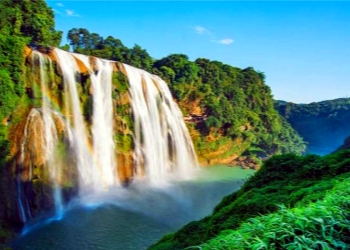
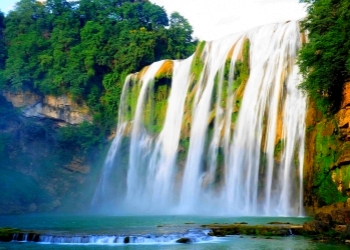
Climate of Huangguoshu Waterfall Scenic Area
Huangguoshu Waterfall Scenic Area belongs to the Middle subtropical zone and is a typical karst area with a mild climate and abundant rainfall. The annual rainfall is more than 1300 mm. The rain is concentrated from May to July, and the average monthly rainfall is more than 200 mm, especially in June, when the rainfall is nearly 300 mm.
The subtropical climate of Huangguoshu Waterfall means that temperatures remain relatively constant throughout the year, with warm summers and mild winters. This makes the area suitable for tourism throughout the year, allowing visitors to enjoy the waterfall's beauty regardless of the season.
Best Time to Visit Huangguoshu Waterfall
The optimal season to visit Huangguoshu Waterfall falls between May and October, particularly during the rainy months from June to August.
In Spring (March to May) and Winter (December to February), the waterfall flows at a slower pace, much like a graceful dancer performing a mellow melody. The scenery during these seasons offers a serene and meditative experience. Summer (June to August) truly showcases the grandeur and wild beauty of Huangguoshu Waterfall. You can witness the powerful cascade of water and hear its roaring sound, a thrilling experience that leaves a lasting impression. Autumn (September to November) brings a different charm to the waterfall. Although the waterflow is not as intense as in Summer, the scenery is still captivating.
Huangguoshu Waterfall Scenic Area & Its Attractions
The three major scenic areas of Huangguoshu Waterfall are renowned for their unique natural beauty and cultural significance. Each area offers a distinct perspective of this magnificent waterfall, making a visit to Huangguoshu Waterfall a truly immersive experience.
Huangguoshu Waterfall (黄果树瀑布景区)
Huangguoshu Waterfall, formerly known as Baishui River Waterfall, stands as the largest waterfall within its eponymous group and holds a renowned position among the world's magnificent waterfalls, particularly admired for the magnitude of its flowing water. Boasting a height of 77.8 meters and a width spanning 101 meters, this natural wonder is a prime example of an erosion fracture waterfall characteristic of karst landscapes.
Standing on the observation deck, one is treated to a spectacle of roaring waters plunging from a towering cliff, resembling a upside-down milky way. The thundering noise is deafening, and the misty spray creates a dreamy atmosphere. As the sunlight filters through, it forms vibrant rainbows that seem to bridge the gap between reality and fantasy.

Bonsai Garden (盆景园)
Bonsai Garden offers a captivating tapestry of miniature bridges, trickling streams, enigmatic rocks, and exquisite plant life. With over 30 diverse varieties of bonsai, including fiery firethorns, vibrant lagerstroemia indica, ancient gingkos, resilient diospyros armata, vibrant azaleas, and majestic banyans, it's a miniaturized paradise that brings the essence of natural beauty into your very own space.
Water-Curtain Cave (水帘洞)

Nestled alongside the majestic Huangguoshu Waterfall, the Water-Curtain Cave stands at a soaring height of 40 to 47 meters. Resembling a dragon soaring along the hillside, extends for an impressive length of 134 meters. It holds a special place in Chinese culture as the famous scene in “Journey to the West” - Sun Wukong and his offspring’s home. For travelers, the Water-Curtain Cave offers a unique opportunity to appreciate the grandeur of the waterfall from various angles.
Rhinoceros Pool (犀牛潭)
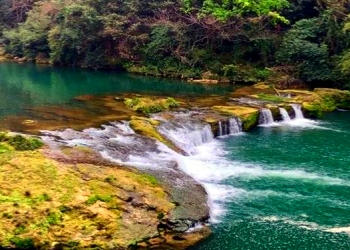
Rhinoceros Pool nestles at the foot of the majestic Huangguoshu Waterfall, a place where the waterfall plunges from its lofty heights, striking a deep, mysterious pool below. The pool earned its unique name due to its resemblance to the shape of a rhinoceros. With a depth of 11.1 meters, it lies at the heart of a verdant landscape, flanked by cliffs clothed in a variety of lush vegetation.
Doupotang Waterfall Scenic Area (陡坡塘景区)
The Dobotang Waterfall Scenic Area is situated 1 kilometer upstream of the Huangguoshu Waterfall. Within this scenic spot, there stands a magnificent waterfall, formed by a calcified beach dam, with a crest width of 105 meters and a height of 21 meters. It is the widest-crested waterfall in the Huangguoshu Falls group. At the top of the Dobotang Waterfall, there lies a vast dissolved pool spanning an area of 15,000 square meters. The waterfall itself cascades over a calcified beach dam that extends for over 100 meters in a curving path.
During periods of normal water flow, the Baishui River maintains a steady but not overly large volume, of clear and transparent water. The waterfall's water layer spreads evenly across the gentle surface of the falls, resembling a thin, semi-transparent veil that shimmers with silver light under the sun. However, during the rainy season, the Baishui River turns muddy due to the influx of silt carried by mountain torrents, giving it a yellowish hue. At this time, the Dobotang Waterfall sheds its usual delicate beauty and transforms into a fearsome and majestic spectacle, displaying unparalleled ferocity and grandeur.
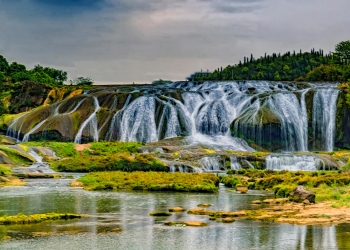

Tianxingqiao Scenic Area (天星桥景区)
The Tianxingqiao Scenic Area is located 6 kilometers downstream from the Huangguoshu Waterfall Scenic Area. With a planned area of 7 square kilometers and a developed area for tourists of 4.5 square kilometers, the scenic area comprises three main sections: the Natural Bonsai Garden, the Tianxing Cave, and the Stone Forest in Water. It embodies the essence of karst landscapes, integrating mountains, water, forests, caves, roots, vines, stones, and waterfalls into a cohesive whole.
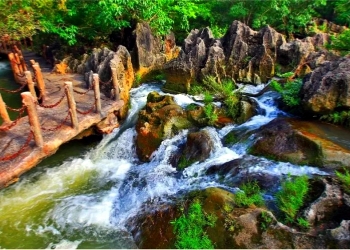
Natural Bonsai Garden (天然盆景园)
The Natural Bonsai Garden, stretching approximately 800 meters, is the first attraction upon entering the Tianxing Bridge Scenic Area. Here, visitors are treated to a stunning display of various-sized natural rock and water stone bonsai arrangements. A three-kilometer-long stone pathway threads through cliffs, rock crevices, and narrow gaps, with stones scattered in the water beneath, forming 365 stepping stones.
Tianxing Cave (天星洞)

Tianxing Cave, situated in the heart of the scenic area, is a remarkable karst formation devoid of water. Its interior extends approximately 150 meters in length and reaches a majestic height of 50 meters. Within this cavernous space, four towering stalagmites loom overhead, each exceeding 20 meters in height. A brief stroll through the cave reveals an array of captivating formations, including various shapes of stalagmite, stalagnates, Corallodiscus flabellatus. At the exit of Tianxing Cave, travelers are treated to the sight of the Maoshuitan Waterfall.
Stone Forest in Water (水上石林区)
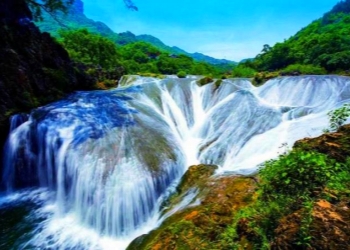
Stone Forest in Water, this section of the riverbed wide up to 400 meters, an area of about 0.4 square kilometers of stone forest is growing in the riverbed. The stone forest is covered with cacti and small shrubs. Yinlian Zhuitan Waterfall (银链坠潭瀑布) and Xingxia Waterfall (星峡瀑布) are located on the left and right sides of the Waterstone forest. Yinlian Zhuitan Waterfall is only more than ten meters high, above into a funnel shape, the bottom is a trough. The river spread evenly on each leaf, like thousands of large and small silver chains, slowly falling into the pool.
Travel Tips
Address: Huangguoshu Town, Zhenning Buyi and Miao Autonomous County, Anshun City, Guizhou Province
Opening Hours: 07:00 - 18:00 (Mar. to Nov.); 07:30-18:00 (Dec. to next Feb.)
Tickets Price: CNY 160
Best Time to Visit: May to October, especially from June to August (rainy season)
Recommended Visiting Time: 6-7 hours
Popular Activities: photography, hiking
Scenic Spot Level: National AAAAA Tourist Attraction
Climate: Subtropical monsoon climate



































